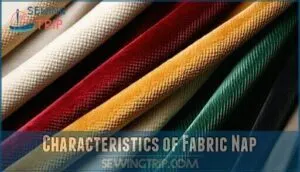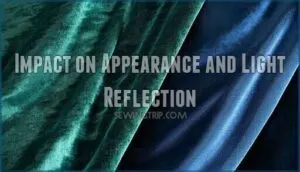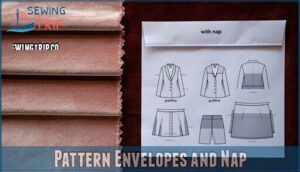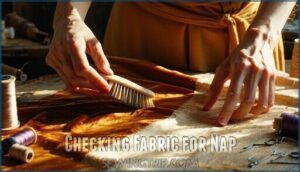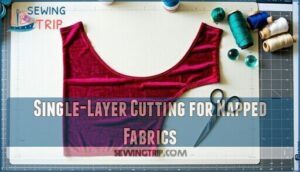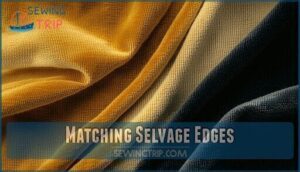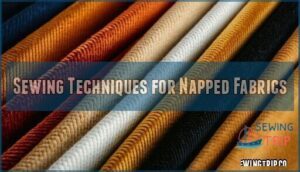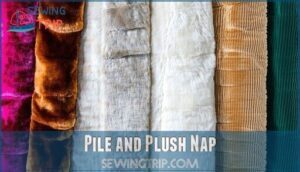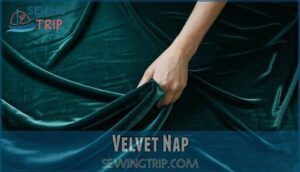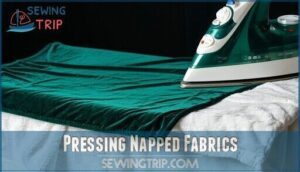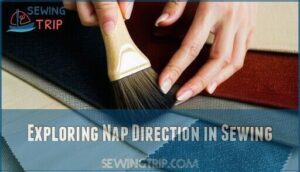This site is supported by our readers. We may earn a commission, at no cost to you, if you purchase through links.
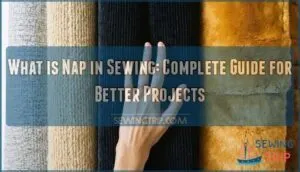
You’ll notice this when running your hand across velvet, corduroy, or fleece – it feels smooth in one direction and rough in the other.
This happens because the fabric’s surface fibers lean in a specific direction, creating a pile that reflects light differently.
When you’re sewing with napped fabrics, you must cut all pattern pieces in the same direction to avoid color variations in your finished garment.
Ignoring nap direction can make your project look like it’s made from different fabrics entirely, even when using identical material.
The secret to professional-looking results lies in understanding how nap affects your cutting layout and pressing techniques.
Table Of Contents
- Key Takeaways
- Understanding Fabric Nap
- Characteristics of Fabric Nap
- Impact on Appearance and Light Reflection
- Cutting and Layout Considerations
- Sewing Techniques for Napped Fabrics
- Identifying Nap Direction
- Pressing Napped Fabrics
- Exploring Nap Direction in Sewing
- Frequently Asked Questions (FAQs)
- Conclusion
Key Takeaways
- You’ll feel the difference when stroking napped fabric – smooth in one direction, rough in the opposite, because raised fibers lean in a specific direction, creating directional texture
- Cut all pattern pieces facing the same nap direction to prevent color variations that make your garment look like it’s sewn from completely different fabrics
- Use single-layer cutting and match selvage edges when working with velvet, corduroy, or fleece to maintain consistent pile direction and professional results
- Press napped fabrics face-down on a towel with low heat and never slide the iron directly across the surface to avoid crushing the delicate raised fibers
Understanding Fabric Nap
When you run your hand across velvet or corduroy, you’re experiencing fabric nap—the raised fibers that create texture and visual depth.
Fabric nap transforms ordinary cloth into luxury through the magic of directional fibers.
Nap Definition: it’s the directional surface created when fibers are brushed or woven to lie in one specific direction during Nap Creation.
This textile technique has ancient roots, with Nap History tracing back to the 15th century when craftsmen discovered how manipulating fiber direction enhanced fabric appeal.
The Nap Purpose goes beyond aesthetics.
These raised fibers catch and reflect light differently depending on viewing angle, creating the signature color variations you notice in napped fabric.
Nap Benefits include enhanced texture, visual interest, and tactile appeal that transforms ordinary cloth into luxury material.
Understanding sewing nap means recognizing that fabric nap affects every aspect of your project.
The nap direction determines how light hits the surface—smooth one way, rough the opposite.
This pile direction consistency becomes essential when cutting pattern pieces, as mismatched directions create unwanted color variations in your finished garment.
Characteristics of Fabric Nap
Understanding fabric nap characteristics helps you achieve professional sewing results.
Fabric nap refers to raised fibers that create surface texture and directional appearance on your material.
These fibers lie in one specific direction, giving fabric its unique pile direction and fabric softness.
When you run your hand across napped fabric, you’ll feel the fiber direction clearly.
Stroking with the pile feels smooth, while going against it feels rough.
This raised fiber structure creates varying light reflection patterns that change the fabric’s appearance depending on your viewing angle.
Pile height varies between different napped fabrics.
Velvet has short, dense fibers, while corduroy features longer raised sections.
The fabric texture directly affects how light bounces off the surface, creating darker or lighter appearances based on fiber direction.
Considering fabric weight considerations is also essential for the final garment’s drape and structure.
These fabric nap characteristics mean you can’t ignore pile direction when cutting and sewing your projects.
Impact on Appearance and Light Reflection
The fabric nap creates a visual symphony through its interaction with light.
When you run your hand with the nap direction, the surface appears lighter and smoother, while stroking against it reveals darker, matte tones.
This color variation occurs because pile direction affects how light bounces off the fabric texture.
Velvet demonstrates this perfectly – brush one way and you’ll see bright sheen effects, brush the opposite direction and witness deep, rich shadows.
This shading creates visual depth that can make identical fabric pieces look completely different.
The texture perception changes dramatically based on viewing angle.
Smart sewers use this to their advantage, choosing nap direction to enhance their project’s fabric appearance.
Whether you want subtle elegance or bold contrast, understanding how pile direction influences light reflection helps you make informed decisions that elevate your finished garment’s visual impact.
Cutting and Layout Considerations
When you’re working with naped fabrics, proper cutting and layout become essential for achieving professional results.
You’ll need to pay extra attention to pattern placement and fabric requirements to guarantee all pieces match perfectly.
Pattern Envelopes and Nap
Most pattern envelopes include nap notations that specify different fabric requirements for directional fabric versus regular material.
Look for layout diagrams showing "with nap" options—these pattern adjustments guarantee all pieces face the same direction.
When working with napped fabric, grainline importance becomes critical since you can’t flip pieces to save fabric, and the pattern envelope guides your cutting strategy, preventing costly mistakes with expensive directional fabrics.
Checking Fabric for Nap
To check sewing nap, start with hand feel – stroke the fabric in both directions.
You’ll notice smoothness with the pile direction and resistance against it. Use visual inspection under different lighting angles to spot color or sheen changes.
Try a brush test, gently brushing opposite ways to reveal texture differences. The folding comparison method works well – fold fabric sections together and compare how light reflects off each surface.
Fabrics with a nap or directional patterns are called one-way fabrics, and must be cut carefully. When facing nap uncertainty with subtle textures, always treat the fabric as napped to avoid mismatched appearance in your finished project.
Single-Layer Cutting for Napped Fabrics
When working with napped fabric, single-layer cutting becomes your best friend for achieving professional results.
This method prevents the fabric layers from shifting and guarantees each pattern piece captures the nap direction correctly.
Here’s your step-by-step approach for cutting accuracy:
- Lay fabric face-up – Position the napped fabric with the raised surface visible, allowing you to see the grain alignment clearly
- Secure with pattern weights – Place weights along pattern edges to prevent shifting during cutting, reducing fabric waste
- Cut in nap direction – Follow the fabric nap direction consistently across all pieces for uniform appearance
- Use sharp tools – Sharp rotary cutters or scissors create clean edges without disturbing the pile texture
Single-layer cutting requires more time but delivers superior nap consistency throughout your project.
You’ll maintain proper pattern layout while avoiding the frustration of mismatched pieces.
For ideal results, consider using specialized cutting tools.
This cutting method works especially well with velvet, corduroy, and fleece fabrics where sewing nap direction matters most for the final appearance.
Matching Selvage Edges
When cutting napped fabrics, proper selvage alignment becomes your compass for success.
Match your selvage edges carefully to maintain grainline accuracy and fabric stability throughout your project. This technique guarantees fabric orientation stays consistent, preventing pile direction mishaps that create uneven texture.
Pattern matching becomes effortless when you align selvages first, then position your pieces. Your cutting efficiency improves dramatically as this method guides fabric nap direction placement.
A selvage edge tool can assist in this process. Remember, napped fabrics demand respect for their directional nature to achieve professional results.
Sewing Techniques for Napped Fabrics
When sewing napped fabrics, you’ll need to follow specific techniques to maintain the fabric’s texture and appearance throughout construction.
These methods guarantee your finished project looks professional and consistent across all seams and edges, ensuring a consistent appearance.
Following Nap Direction
Following the nap means aligning all pattern pieces in the same direction for consistent appearance.
Run your hand across the fabric to find which way feels smooth—that’s your guide. Cut every piece with nap flowing the same way to avoid mismatches that make your project look like patchwork.
Understanding how to align pattern pieces with proper grain direction is also essential for achieving a professional look.
This uniform approach creates a professional finish while ensuring comfort when wearing the garment.
Examples of Napped Fabrics
You’ll encounter numerous napped fabrics in your sewing journey, each offering unique characteristics.
Velvet provides luxurious texture but requires careful handling for velvet durability. Corduroy variations include wide-wale and pinwale options, perfect for jackets and pants.
Fleece offers warmth and comfort in casual wear. Suede alternatives like faux suede give elegance without leather’s cost.
Velour applications range from athletic wear to formal garments. Moleskin projects benefit from its soft, brushed surface.
Understanding nap in sewing helps you select appropriate napped fabric for your creative vision. Some of these materials undergo a specific finishing process to achieve their unique texture.
Identifying Nap Direction
You’ll need to identify which direction the fabric’s nap flows to guarantee all pattern pieces match perfectly.
Testing for nap direction is simple – just run your hand across the fabric surface and feel for the smooth versus rough texture difference, which helps to understand the fabric’s behavior.
Types of Fabric With Nap
Recognizing different napped fabric types helps you make informed choices for your sewing projects. Each fabric with nap has unique characteristics that affect how you work with it and the final appearance of your garment.
Velvet characteristics include a dense, luxurious pile that creates rich color depth and dramatic light reflection. Corduroy variations feature raised wales or ribs that run vertically, creating distinctive texture patterns. Fleece properties offer warmth and softness through synthetic fibers brushed to create a cozy surface. Suede applications provide elegant texture through raised fibers that feel smooth in one direction.
Understanding fabric pile direction is key when working with these materials:
- Velour alternatives like polyester velvet offer similar luxury at lower cost
- Napped fabric types include flannel, moleskin, and terry cloth
- Pile fabrics have extra yarns woven into the structure
- Brushed fabrics get their texture through mechanical finishing
Each nap in sewing application requires specific techniques. You’ll find that some fabrics have subtle nap while others display obvious directional differences that dramatically change appearance.
Pile and Plush Nap
Different types of nap in sewing create unique textures that affect your project’s final appearance.
Deep pile fabrics like faux fur have long, dense fibers that create dramatic texture changes when brushed in different directions.
Crushed velvet offers an irregular, luxurious surface where the pile lies in multiple directions.
Plush toys require fabrics with soft, medium-length pile that feels comfortable against skin.
Corduroy ribs create linear nap patterns that must align consistently across pattern pieces.
Understanding fabric pile direction helps you identify whether you’re working with tight, uniform pile or looser plush nap, ensuring proper cutting and construction for professional results.
Velvet Nap
Velvet stands out among napped fabrics with its luxurious velvet pile that creates stunning visual effects. The velvet direction dramatically affects how light reflects off the surface, producing that signature velvet sheen that makes garments appear rich and elegant.
When you run your hand across velvet, you’ll feel the difference immediately. Stroking with the nap direction feels smooth, while going against it creates resistance. This fabric nap properties make velvet tricky but rewarding to work with.
For sewing with nap success, cut all pattern pieces facing the same velvet direction. This prevents color variations that occur when pieces face different ways. Crushing velvet happens easily during handling, so use gentle pressure when cutting and sewing. To prevent shifting, consider using tissue paper for cutting between fabric layers.
Velvet care requires special attention during pressing. Never place an iron directly on the pile. Instead, use steam and a pressing cloth to maintain sewing fabric nap consistency throughout your project.
Pressing Napped Fabrics
Once you’ve mastered identifying nap direction, proper pressing becomes your next critical skill. Napped fabric requires gentle handling to prevent crushing those delicate raised fibers.
Always press on the wrong side using low heat settings. Place your napped fabric face-down on a thick towel – this creates cushioning that protects the nap from flattening.
For high-pile fabrics like velvet, invest in a needle board designed specifically for this purpose. Many sewers find needle board velvet essential for delicate fabrics.
Use a pressing cloth as your shield against direct iron contact. This barrier prevents shine and fabric damage while allowing heat transfer. Steam usage works wonderfully for most napped fabrics, but check your fabric’s care label first – some synthetics say "no steam."
Apply gentle pressure with lifting motions rather than sliding the iron. Focus on seam pressing by using just the iron’s tip along seam lines. Test your pressing techniques on fabric scraps first to determine ideal heat settings and timing for nap protection.
Exploring Nap Direction in Sewing
After mastering proper pressing techniques, understanding how nap direction affects your project’s final appearance becomes your next priority.
The way those raised fibers lie determines whether your garment looks polished or patchwork.
Nap direction aesthetics play a major role in fabric appearance.
When you brush napped fabric upward, it creates a darker, richer color.
Brushing downward produces a lighter, shinier effect.
This nap direction changes how light reflects off your fabric, making identical pieces look completely different if cut incorrectly.
For comfort considerations, most sewers orient nap downward from shoulder to hem.
This direction feels smoother when you run your hand down the garment.
However, creative nap usage can involve mixing directions intentionally for design effects.
Always check fabric nap properties before cutting.
Run your hand across the surface – smooth indicates "with the nap," while rough means "against the nap."
This simple test prevents costly mistakes and guarantees your sewing with nap produces professional results every time.
Frequently Asked Questions (FAQs)
What does "with nap and without nap" mean in sewing?
Like choosing paint brushes that create different textures, "with nap" means you’ll cut all pattern pieces facing the same direction on directional fabrics.
While "without nap" lets you cut pieces any direction on non-directional fabrics.
What is a nap in fabric?
Fabric nap refers to raised fibers on a fabric’s surface that lie in one direction, creating texture and affecting how light reflects.
You’ll notice it feels smooth one way, rough the opposite direction.
What is napping in fabric finishes?
Napping creates fabric’s raised, fuzzy surface through brushing fibers in one direction during finishing.
You’ll see this process on flannel, fleece, and brushed cotton, where mechanical brushing lifts surface fibers for softness.
Can napped fabrics be machine washed safely?
You can machine wash most napped fabrics, but check care labels first. Use gentle cycles, cold water, and avoid fabric softeners that’ll flatten the nap.
How much extra fabric is needed for nap?
You’ll typically need 10-25% extra fabric when working with nap. The exact amount depends on your pattern’s complexity, piece count, and fabric width, requiring strategic layout planning.
What needles work best with napped fabrics?
Use universal needles (size 80/12 to 90/14) for most napped fabrics. Switch to ballpoint needles for knit naps like fleece. Sharp microtex needles work well for dense pile fabrics like velvet.
Do interfacings affect nap direction or appearance?
Interfacing won’t change your fabric’s nap direction, but it can flatten the pile and dull the surface texture.
Choose lightweight interfacing and test on scraps first to avoid compromising your fabric’s beautiful directional sheen.
Can napped fabric pieces be sewn together backwards?
Sewing napped fabric pieces backwards creates uneven color and texture, making your garment look patched from mismatched materials. Always align all pieces with nap running the same direction.
Conclusion
Surprisingly, understanding what’s nap in sewing can transform your projects from amateur-looking to professional overnight.
You’ve learned that nap affects how light reflects off fabric surfaces, creating different appearances when viewed from various angles.
Remember to cut all pattern pieces in the same direction, use single-layer cutting methods, and press carefully with the grain. Master these techniques, and you’ll never wonder why your velvet dress looks patchy again.
- https://www.threadsmagazine.com/2020/04/22/qa-napped-fabrics-vs-pile-fabrics
- https://www.youtube.com/watch?v=t4433XeabJY
- https://threadistry.com/blog/fabric-nap/
- https://www.sewing.org/files/guidelines/4_218_working_with_napped_fabrics.pdf
- https://untitledthoughts.com/blogs/sewing-basics/working-with-nap-fabrics

